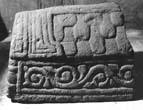Select a site alphabetically from the choices shown in the box below. Alternatively, browse sculptural examples using the Forward/Back buttons.
Chapters for this volume, along with copies of original in-text images, are available here.
Object type: A house-shaped tomb cover [1]
Measurements: L. 45.7 cm (18 in) at base; W. 37 cm (14.5 in) at base > 33 cm (13 in) below pitch of roof; H. 30 cm (11.8 in) at end, 33.3 cm (13.2 in) at break in centre
Stone type: Sandstone (pollution blackened), yellow-buff, medium to coarse-grained, hard quartz cemented, slightly micaceous. Middle Coal Measures Group, Carboniferous (Local Thornhill Rock?). [G.L.]
Plate numbers in printed volume: Ills. 237-9
Corpus volume reference: Vol 8 p. 147-8
(There may be more views or larger images available for this item. Click on the thumbnail image to view.)
A house-shaped tomb cover with a bombé roof, so that it is shaped like an upturned boat. The roof ridge is plain.
A (long): The roof is tegulated, with three rows of tegulation type 7 and one row of type 5. The tegulated area does not extend the full length of the roof: the right edge has not been cut back to form tiles, but instead is scored by five deep parallel lines running down the roof, with, on the outer edge, a narrow double-bordered panel divided by horizontal lines into a pattern of alternate short and long elements — a crude rendition of a baluster moulding (see face B below and Dewsbury 14 above). The innermost strip of this end panel has a shallow, lappet-like feature above the eave, overlapping the lowest tile.
The side of the tomb below has a moulding on the right in the form of a column with base and capital. Adjacent to this, and below the eaves of the roof, is a horizontal panel with a shallowly modelled border on three sides, the fourth side incomplete. Within the panel is a running scroll, a flatter version of that on Dewsbury 14, of which three volutes survive, with buds, round berry bunches, pointed leaves and one set of paired leaves enclosing a leaf or flower.
B (end): The boat-shape sides of the tomb are very apparent on this face, which makes the curving columns with their capitals and bases look very odd. The columns support the flat moulding at the edge of the roof. The face has an inner flat but raised moulding which follows the curves of the walls and roof, and at the bottom rises to form a mound beneath a cross with wide V-shaped armpits of very simple form. The surface around the cross is dressed back
C (long): The outer border of the roof is the same as on face A but instead of the plain incised lines of A the panel forms a wide L-shape with a double moulding. The foot of the 'L' seems another version of the shallow lappet found on the opposite face. The tegulation on the inner part of the roof is a version of type 2c.
The side below is treated similarly to that on face A, with the running scroll better preserved. The volutes end in round berry bunches, and in the spandrels are rounded buds or pointed leaves.
D (end): Missing
This is a very interesting piece because of its relationship to the well-known Anglo-Scandinavian monument-type, the hogback: indeed it was classified by Lang (1967 and 1984) as a hogback (see Chap. IV, p. 38). This, however, is clearly a house-shaped tomb cover or shrine. The roof is peaked and the sides are slightly bombé. The decoration of the surviving end is clearly architectural, including a gable with a cross, and therefore possibly representing a church. The shrine/ house-shaped tomb in England, of which the most famous is the 'Hedda' stone at Peterborough (Cramp 1977, 211, fig. 57c), clearly relates to the late eighth-, early ninth-century revival of late antique and early Christian forms and iconography, also discussed here in relation to Dewsbury 1–5 and 9. Such pieces, which may have included box sarcophagi as well as solid house-shaped covers (as with examples from Breedon, Castor, Peterborough and Bakewell: Cramp 1977, figs. 57a–b, 58b, 59a–c, 60a), are most recognisable when they follow the late antique mode of figures within an architectural arcade. At Dewsbury this relatively small monument has architectural features and details drawn from contemporary building types, in its implication of a gable end on face B and its tegulation, but has on its low sides room only for a horizontal plant ornament, of a type similar to that on the cross-base fragment, Dewsbury 14, though somewhat heavier.
It has been suggested that the hogback is a development of the Anglian house- or shrine-tomb (Collingwood 1927, 164-73; Bailey 1980, 85–100), and the Dewsbury tomb cover seems to provide the perfect model for this later development. See also Chap. IV, p. 38.



